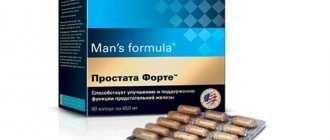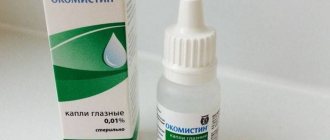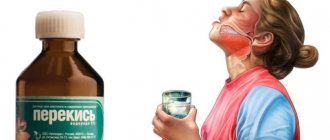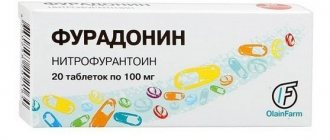Miramistin is a substance with an antimicrobial effect. This is an antiseptic that has found application in various fields, including in the treatment of intimate diseases. It is prescribed for the treatment of chlamydia and syphilis, for candidiasis of the genital organs, as well as for disinfection of the genital tract after childbirth.
Composition and principle of action
The drug contains benzyldimethyl[3-(myristoylamino)propyl]ammonium chloride monohydrate. This chemical compound has an antiseptic effect. It is effective against:
- staphylococci;
- streptococci;
- pseudomonas;
- Klebsiella;
- coli.
Miramistin is also used to destroy pathogenic fungi, viruses (including HIV), and pathogens of sexually transmitted infections. This antiseptic has a complex effect. Its functions include:
- elimination of inflammatory processes;
- preventing wound infections;
- stimulation of regeneration processes;
- absorption of purulent secretions.
Miramistin is a local drug. It is not absorbed into the blood and does not have a systemic effect on the body. Consequently, the drug has virtually no restrictions and extremely rarely provokes side effects.
Operating principle and effectiveness assessment
The principle of action of Miramistin for urethritis in men and women is the same.
The drug in the form of a solution (other forms of release are available) is injected into the urethra and rinses it. When passing through the urethra, the drug kills viruses, bacteria, fungi, preventing infection of microcracks that often appear with urethritis. Miramistin also eliminates the inflammatory process itself caused by the activity of bacteria. The components of the composition, which in some people lead to a slight burning sensation, with prolonged use, on the contrary, soothe the irritated epithelium. Another important effect of the drug is a general increase in immunity. By washing away pathogenic bacteria, it allows the body to recover and begin to fight the infection on its own. Some components of the composition help improve immunity.
Forms of release of the drug
Miramistin is a clear, colorless liquid that forms foam when shaken. It contains 0.01% of the active ingredient and purified water. The product is packaged in plastic bottles of various sizes - from 50 to 500 ml. For ease of use in the intimate area, the package includes:
- gynecological attachment;
- urological applicator;
- spray nozzle.
The nozzles ensure the most convenient and hygienic use of the product.
Indications for use in the intimate area
Miramistin is a universal antiseptic that is prescribed for the following intimate diseases:
- gonorrhea;
- chlamydia;
- trichomoniasis;
- syphilis;
- genital herpes;
- candidiasis;
- vulvovaginitis;
- endometritis;
- postpartum injuries with suppuration;
- postpartum infections.
Miramistin is used not only in the treatment of sexually transmitted infections, but also as a means of preventing STDs after unprotected sex.
Side effects
When treating urethritis with Miramistin, side symptoms may appear.
Usually they are mild and do not pose a danger to the patient. Miramistin often causes a burning sensation. It is typical for sensitive people. Unpleasant sensations last for the first 10-20 seconds after injection of the substance. This is not a reason to cancel treatment.
A more serious side effect is a burn of the urethra with Miramistin. Serious damage to the mucous membranes occurs if the patient exceeds the dosage of the solution and the duration of rinsing. The burn is characterized by pain during urination, sexual intercourse, and even at rest. If these signs occur, it is important to consult a doctor as soon as possible.
If you are intolerant to some components of the composition, allergic reactions are possible:
- itching;
- redness of the external genitalia;
- mild rash.
If the patient notices the listed symptoms, you should consult a doctor to select an analogue. It is dangerous to continue using Miramistin if you have an allergy.
Instructions for use in the intimate area
Miramistin is applied directly to the genital area. Do this according to the instructions.
- The bottle is removed from the packaging. It is not necessary to shake the medicine.
- A suitable nozzle or applicator is installed on the packaging.
- The medicinal solution is applied to the affected area by pressing the nozzle.
Men need to use a urological applicator to inject the solution into the urethra. Women treat the urethral area and vagina. Additionally, you may need to spray an antiseptic in the anus area and on the inner thighs. This treatment mechanism will protect against sexually transmitted infections.
Miramistin alone is not enough to treat STDs. The antiseptic will play the role of an auxiliary element of therapy.
For chlamydia, gonorrhea and other genital infections, antibiotics (Klacid, Clindamycin, Eithromycin) or fluoroquinolones (Ofloxacin, Pefloxacin) are mandatory. Additionally, you may need to take vitamins and probiotics.
Analogs
Inflammation in the urethra can be relieved not only with Miramistin, but also with similar drugs. You can select them only together with your doctor. If it turns out that you cannot use the original antiseptic due to allergies, you should first stop using the drug, and then, together with your doctor, choose one of the following remedies:
- Mestamidine;
- Chlorhexidine;
- Hexoral;
- Dekasan;
- Hexaspray.
It is worth noting that most of the drugs presented are not effective enough in the fight against urethritis. Therefore, when replacing Miramistin with analogues, the time of therapy may increase. The closest analogue to Miramistin is Mestamidin. When selecting a new drug, you should pay attention to the composition to avoid allergies.
Miramistin should be used not only for treatment, but also for the prevention of urethritis after unprotected sexual intercourse. The drug has a wide range of therapeutic effects and is practically safe for an adult patient. However, it should only be used after consultation to avoid genital burns and allergic reactions.
Miramistin for candidiasis
Thrush, or candidiasis, is a fungal infection of the genital organs, accompanied by the formation of a white coating, curdled discharge and severe itching. For treatment, effective antimycotic drugs are usually prescribed in the form of suppositories for women and creams for men. The use of Miramistin will also be useful. There are several options for using an antiseptic.
- External treatment of the genital organs
. The perineal area is thoroughly irrigated with a medicinal solution using a spray nozzle. To enhance the effect, an antiseptic is injected into the vagina. - Douching
. A small rubber syringe can be used to administer the medication into the vagina. The antiseptic is taken in pure form or diluted with water in a 1:1 ratio. - Washing with solution
. Miramistin in this case will replace ordinary water. The use of detergents is not required.
Treatment of thrush using Miramistin will take 5-7 days. It is important not to stop processing, even if improvement occurs faster. Untimely completion of therapy will provoke a new wave of development of fungal infection and make the pathogenic microorganism more resistant to the antiseptic.
How is Miramistin injected into the urethra?
For the treatment of urethritis, specialized experts recommend using the pharmaceutical drug Miramistin as a complex treatment. It is worth considering that the healing of this disease depends on its forms, so the therapeutic course should be prescribed exclusively by the attending physician, specialized in urethritis. In addition, the regimen for using Miramistin is different depending on the gender of the patient.
Before starting treatment for the disease, you need to undergo a diagnostic examination and pass the necessary tests. Only after this can an individual course be prescribed. For men and women it ranges from 1 to 3 weeks.
For the entire duration of therapy, you should abstain from sex, and also adjust your diet so that it does not contain salty, spicy, fatty and fried foods. Alcohol is also contraindicated for urethritis. It is important to maintain hygiene, change underwear regularly and not share washcloths and towels to avoid infecting other family members.
To cure urethritis in representatives of the stronger sex, the urethra should be sanitized with an antiseptic solution according to the following scheme:
- Prepare a 20-cc syringe with a rubber tip.
- Expose the head of the male genital organ.
- Attach the tip of the syringe and inject the solution into the urethra.
- The medicine should be injected slowly in a volume of 2-3 ml.
- Remove the tip and wait for the fluid to flow out of the urethra on its own.
- If necessary, repeat the procedure several times.
After washing the anterior section of the urethra, the posterior section can be treated, but this should only be done by a specialized specialist within the walls of the hospital. The doctor will need a 5-10 cc syringe equipped with a rubber nozzle.
For illness in women
To treat urethritis in females, Miramistin is used in combination with other pharmaceuticals. The solution is injected 2-3 ml into the urethra once or twice a day for 1.5 weeks.
The procedure is carried out every other day. If the urinary tract disease is caused by chlamydia, then use an antiseptic exposure solution. The procedure takes 10 minutes and is repeated twice a day for a week.
Use after caesarean section
Miramistin has found wide application in obstetrics and gynecology. In particular, this antiseptic is used to treat sutures after a caesarean section. The solution is used according to the following algorithm.
- The bandage is removed from the wound.
- The surface of the skin is pre-treated with hydrogen peroxide. At the same time, the reaction of the wound is monitored. Blistering and hissing are signs of incomplete healing. This is a normal reaction in the first days after suturing. An alarming sign will be purulent discharge from the wound.
- The skin is dried after treatment with peroxide.
- Miramistin is applied. It is better to do this with a sprayer. There is no need to worry about the dosage. The medicine is absolutely safe.
After treatment is completed, a new sterile gauze bandage is applied to the wound. Treatments with Miramistin continue until the sutures are completely healed and the skin is restored.
Use after childbirth
Miramistin will also be useful after natural childbirth. A disinfectant is needed, as this can cause tissue damage. Typically, wounds and abrasions are localized on the walls of the vagina, labia, and cervix. Particular attention is paid to treatments if there were perineal ruptures during childbirth or the woman in labor had an episiotomy.
Treatment of the genitals with an antiseptic begins strictly after hygiene procedures.
The simplest treatment option is to irrigate the genitals using a spray bottle. After natural childbirth, douching with Miramistin solution or inserting sterile gauze swabs soaked in a disinfectant into the vagina is also allowed.
This will speed up the healing of existing wounds, prevent inflammatory processes and destroy pathogenic microorganisms.
Analogues of Miramistin
Miramistin is not the only antiseptic used in the genital area. The comparison table will help you choose an analogue of Miramistin for intimate hygiene. It contains popular and effective remedies. It is impossible to name the single best antiseptic for intimate hygiene. Each of them has its own characteristics, disadvantages and advantages.
| Product name | Mode of application | Advantages | Flaws |
| Chlorhexidine | The solution is used for washing and douching. You can soak a sterile gauze pad with it and treat the skin and mucous membranes with it. | Inexpensive, effective and safe product. Does not cause side effects | There are no special attachments like Miramistin. May cause dryness and painful urination. Cannot be combined with other antiseptics |
| Hydrogen peroxide | The product is applied to a gauze pad or cotton pad. They treat the skin and mucous membranes | It is inexpensive and available in all pharmacies. The product is ready for use. | During long-term storage, it decomposes and loses its properties. Cannot be combined with chlorhexidine |
| Chamomile | Two filter bags are poured with boiling water (0.5 l) and left for 2-3 hours. The resulting solution is used for washing, douching, and sitz baths. | Quickly relieves itching. Normalizes pH levels, relieves pain and discomfort. It's inexpensive | You need to prepare the decoction yourself. |
| Calendula | 50 g of calendula flowers are poured into two glasses of water. The broth is boiled for 10 minutes, cooled, and filtered. The finished product is used for washing | It has a complex effect - heals wounds, suppresses inflammation, relieves itching and burning. Helps destroy pathogenic microorganisms | May cause an allergic reaction. You need to prepare the decoction yourself. Efficiency is lower than that of ready-made pharmaceutical antiseptics |
| Epigen Intim | The spray can is shaken and the affected surface is treated by pressing the nozzle. The standard therapeutic dose is 2-3 presses. Treatments are carried out 3 times a day | It has a natural, safe composition and is gentle. Helps get rid of itching and burning. Used for papillomas | Cannot be used during the menstrual phase of the cycle. May cause an allergic reaction. Costs more than chlorhexidine, hydrogen peroxide or herbs |
| Tar soap | Used for intimate hygiene as regular soap once every two days | Quickly eliminates unpleasant symptoms of sexually transmitted infections. Does not contain synthetic fragrances. Does not provoke allergies. | It washes away the protective film from the mucous membranes, which can lead to disruption of the microflora. May dry out skin with frequent use. |
Another analogue of an antiseptic solution is Miromistin ointment with an active substance concentration of 0.5%. It is successfully used in urology and gynecology. It has the same properties as liquid, but it is used mainly for treating the outer surfaces of the skin and mucous membranes.
How to properly treat urethritis with Miramistin
For local treatment of urethritis, an effective modern generation antiseptic is used - Miramistin, which increases the permeability of cell membranes and suppresses the growth of pathogenic microflora. The drug has a local immunocorrective and general anti-inflammatory effect, which allows its use in a standard treatment regimen. Together with antibiotic treatment, Miramistin® is applied topically in the form of instillations for 10 minutes twice a day. This therapy is carried out in 2-3 courses of 7 days, the interval between which is on average 10-15 days. This method of treatment allows you to avoid unwanted complications such as candidiasis or dysbacteriosis.








